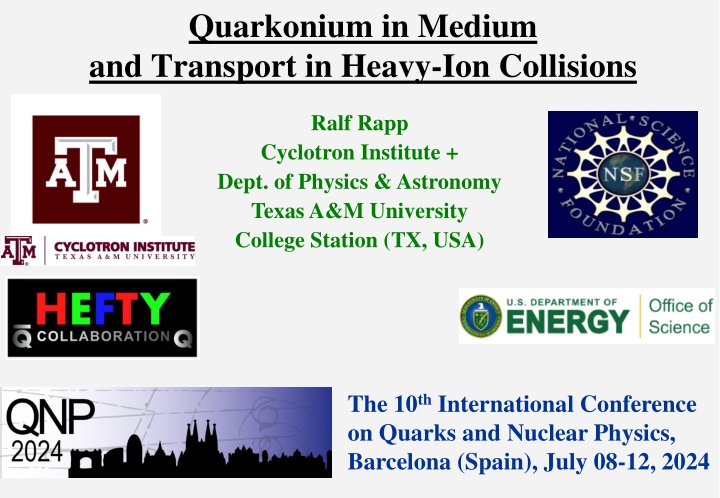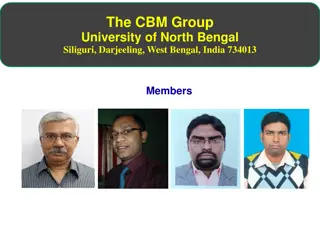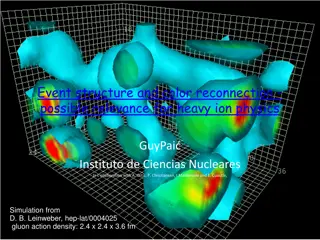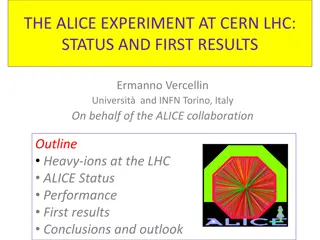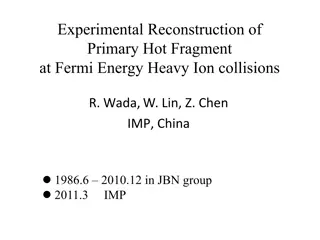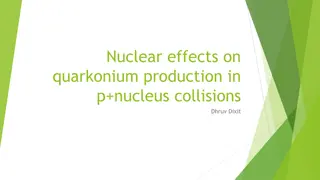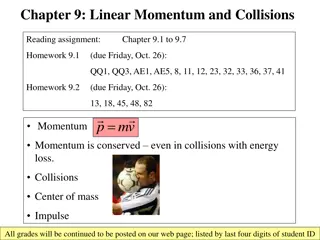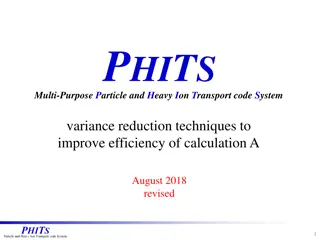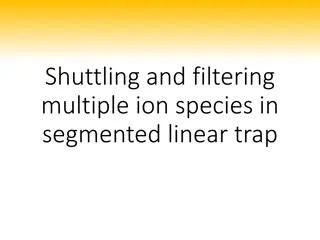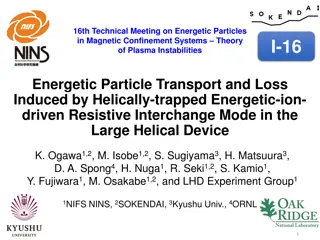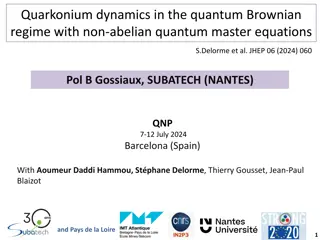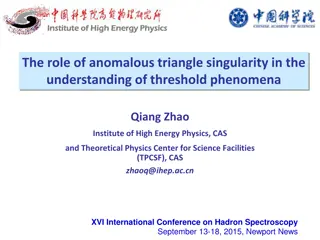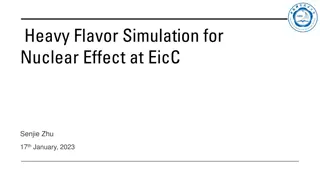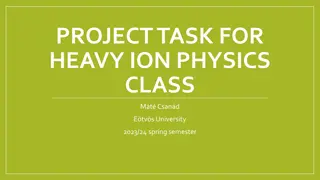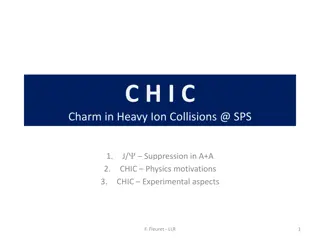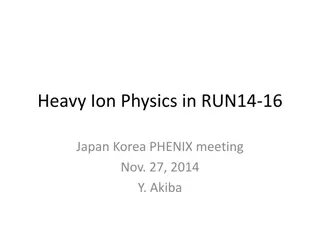Quarkonium in Medium and Transport in Heavy-Ion Collisions
Discussing the properties and behavior of quarkonium in medium and its transport in heavy-ion collisions. Topics include heavy-quark potential, confinement, quarkonia at finite temperature, quarkonium transport, and quarkonia in heavy-ion collisions. Insightful details about in-medium potential and binding energies, spectral functions, and gradual loss of binding energies are presented.
Download Presentation

Please find below an Image/Link to download the presentation.
The content on the website is provided AS IS for your information and personal use only. It may not be sold, licensed, or shared on other websites without obtaining consent from the author.If you encounter any issues during the download, it is possible that the publisher has removed the file from their server.
You are allowed to download the files provided on this website for personal or commercial use, subject to the condition that they are used lawfully. All files are the property of their respective owners.
The content on the website is provided AS IS for your information and personal use only. It may not be sold, licensed, or shared on other websites without obtaining consent from the author.
E N D
Presentation Transcript
Quarkonium in Medium and Transport in Heavy-Ion Collisions Ralf Rapp Cyclotron Institute + Dept. of Physics & Astronomy Texas A&M University College Station (TX, USA) The 10th International Conference on Quarks and Nuclear Physics, Barcelona (Spain), July 08-12, 2024
Intro-1: Heavy-Quark Potential + Confinement Quarks glued together by strings (2S) (3S) (2S) J/ (1S) V(r) [0.5 GeV] Fs(r) = const 1 GeV/fm 105 N Cornell Potential: V(r) = - 4/3 s/r + r [Kaczmarek et al 05] - Describes heavy-quark bound-state spectra (charmonium + bottomonium) - Confirmed by numerical simulations (lattice QCD) - Manifestation of confinement r [0.5 fm] a well-calibrated force!
Intro-2: Quarkonia in Medium In-medium properties: - Mass / binding energy EB(p,T) - Inelastic reaction rate (p,T;EB) [GeV] (1S): color-Coulomb force J/ , (2S), : confining force [Bazavov et al 13] Screening lowers binding energies EB(T) opens phase space for dissociation Dissociation rate (p;T) is key transport parameter for phenomenology QGP Q Q Connection to open heavy-flavor transport
Outline 1.) Introduction 2.) Quarkonia at Finite Temperature -- In-Medium Potential + Binding Energies 3.) Quarkonium Transport -- Kinetic Approaches + Coefficients 4.) Quarkonia in Heavy-Ion Collisions -- Charmonium + Bottomonium -- Bc(6275) 5.) Summary
2.1 Thermodynamic T-Matrix Approach Q - T-matrix equation In-medium potential? Q Infer V via constraints from lattice QCD (free energy): T=194 MeV T=320 MeV Weak screening, large collisional widths Im Remnants of confining force above Tc! V > F [Liu+RR 15]
2.3 Quarkonium Spectral Functions Bc [Tang et al 23] [Liu et al 18] J/ melts near T~ 300 MeV (cb) states in between and P-waves dissolve much earlier (1S) survives to T ~ 500 MeV
2.4 In-Medium Quarkonium Binding Energies Gradual loss of binding sequential dissolution
Outline 1.) Introduction 2.) Quarkonia at Finite Temperature -- In-Medium Potential + Binding Energies 3.) Quarkonium Transport -- Kinetic Approaches + Coefficients 4.) Quarkonia in Heavy-Ion Collisions -- Charmonium + Bottomonium -- Bc(6275) 5.) Summary
3.1 Quarkonium Transport in URHICs 0 0.5 5 10 | | | | [fm/c] fireball time c c- production + CNM effects cc wave pack. - c-quark diffusion in QGP ~ Tmelt: can form QGP kinetics c+c - ~ Tpc: c and c hadronize hadronic kinetics - form 1fm/c ceq ~5fm/c 1/EB eq ~ 1/ (quantum) (quantum)
3.2 Quarkonium Transport Models in QCD Matter Statistical Hadronization Model Along with all other hadrons, quarkonia are produced at QCD phase boundary [PBM+Stachel 00, Gorenstein et al 02, , Andronic et al 21] Semiclassical Transport Models Evolve quarkonium phase space distributions through QCD medium, initial suppression followed by regeneration for T < Tmelt (even in QGP) et al 03, Zhuang et al 05, Zhao et al 07, Ferreiro et al 11, van Hees et al ] Open Quantum Systems Evolve QQ-reduced density matrix in heat bath (EB << heat) Quantum-Brownian Motion ,n= =Cn Cn [Spieles et al 97, Thews et al 01, Grandchamp+RR 01, Ko et al 02, Bratkovskaya - [Akamatsu, Blaizot et al, Brambilla et al, Escobedo et al, Yao et al, Gossiaux et al, Song et al, ]
3.3 Semiclassical Transport + Coefficients Semi-classical transport Boltzmann eq. p f = Ep f + Ep D - D J/ ?? ?? ??) = (? ? Rate equation: c- c J/ eq(m ,T;Ncc) = c2 n (T) VFB Equilibrium limit: N - Heavy-quark number ~ conserved after initial hard production introduce fugacity c(T): Ncc = c nc(T) VFB(t) cc N eqdepends quadratically on charm cross section!
- + g,q c + c + X Reaction rate in QGP: (p,T,EB) ~ d3pi,f (4)(Pi-Pf)|Mi ccX|2 fi(1-ff) Large binding EB T: gluo-dissociation ( singlet-to-octet ) Small binding EB< mD quasi-free/Landau damping q q Gluo-dissociation small, inelastic scattering dominates
3.4 Binding Energies + Reaction Rates: Y States 1S 1P 2S 1S 2S 1P 1S 1P 2S [Du et al 18] Reduced binding accelerates dissociation (opens phase space) Dissociation rate depends on medium particle distribution
Outline 1.) Introduction 2.) Quarkonia at Finite Temperature -- In-Medium Potential + Binding Energies 3.) Quarkonium Transport -- Kinetic Approaches + Coefficients 4.) Quarkonia in Heavy-Ion Collisions -- Charmonium + Bottomonium -- Bc(6275) 5.) Summary
4.1 Key Observables in Heavy-Ion Collisions Nuclear modification factor: Quarkonium yield in AA relative to pp collisions: ??????? ????? ??????? RAA( (Npart) ) = nnn Peripheral Collision: Central Collision: Npart ~ 350 Npart ~ 40 t [fm/c]
4.2 J/ at SPS (17 GeV) and RHIC (200 GeV) Ti ~ 350 MeV Ti ~ 230 MeV Large nuclear absorption at low s SPS: J/ suppression mostly from excited states feeddown : c , J/ + X RHIC: suppression and regeneration increase!
4.3 Charmonia at the LHC (5020 GeV) Centrality pT Dependence Ti ~ 550 MeV Mid- Rapidity Forward Rapidity Substantial regeneration, concentrated at low pT
4.4 Bottomonium Transport RHIC LHC Ti ~ 550 MeV Ti ~ 350 MeV Strong suppression; similar for (1S) at RHIC + LHC ? Regeneration significant for (2S) at LHC ?
4.5 Excitation Functions: SPS - RHIC - LHC Charmonium Bottomonium Gradual increase of total J/ RAA Regeneration and suppression increase Regeneration concentrated at low pT Gradual suppression Regeneration (N eq) small Qualitative difference from J/ [NA50, PHENIX, STAR, ALICE, CMS]
4.6 Bc(6275) Universality test for transport models Rare in pp collisions (c + b quark needed) dNc/dy ~ 30 in Pb-Pb(5TeV) collisions Need low-pT data! caveat: pp cross section in the denominator [Wu et al 24]
5.) Summary Quarkonia can probe in-medium QCD force (not temperature) Remnants of confining force prevail above Tc quarkonium ground states survive (well) into the QGP (+ key role in generating strongly coupled QGP) Semi-classical transport approaches predict interplay of regenerated J/ s vs. suppressed s in heavy-ion collisions Exotic quarkonia provide further unique insights + tests Ongoing theory efforts to develop + apply quarkonia quantum evolutions, scrutinizing the robustness of semi-classical approaches
3.2 Snapshot of Quarkonium Transport Results RHIC LHC: centrality LHC: momentum mostly suppression substantial regeneration, concentrated at low pT Bottomonia mostly driven by suppression, regeneration small even at the LHC
4.6 X(3872) Does X(3872) production in heavy-ion collisions reveal internal structure information? Larger size (molecule vs. tetraquark) larger yield -- or else?
4.6.2 In-Medium X(3872) Production Models Coalescence Models: parton (fi) projection on hadron wave fct. W( ) : hadron radius NX ~ Nmol >> Ntetra [H. Zhang et al 20] ??? ?? Transport Approach: [B. Wu et al 20] ??) = ? (?? ?? - Equilibrium limit larger for more strongly bound state Nmol < Ntetra
3.4 Charmonia - Open-HF Coupling II: Elliptic Flow QGP charm-quark diffusion + resonance recombination Recombination reaches out to pT ~ 8 GeV[He,Wu+RR 22]
2.4 Heavy-Quark Potential Extraction from Data Ansatz for in-med. potential Parameterize T-dependence of mD~ T, 1/RSB ~ mS(T; ) determine in-med. binding energies EY(mD,mS) Compute Y [EY] - also requires HQ-medium coupling - perturbative: s ~ 0.3 - non-perturbative: K 5 QGP _ Q Q Deploy transport approach to fit ( ; K) to data at RHIC + LHC [Du,Liu+RR 19]
3.4 Statistical Extraction of Heavy-Quark Potential Fit Results In-Medium Potential Strongly-coupled solution: remnants of confining force survive well above Tc Not unique [Du et al 19] 2/dof 1
3.3 Coupling of Quarkonia + Open HF Transport QGP c- Boltzmann: c Gain term: Quasifree: Simultaneous c-quark diffusion + charmonium kinetics (same M2pQCD * K) J/ yield + spectral shape require K 5 Strong coupling for open + hidden HF [Du+RR 22]
3.5 (2S) in dAu and pPb d-Au (0.2TeV) p-Pb (5.02TeV) [ALICE] [PHENIX] - -EPS09 noticeable and little J/ suppression, consistent with comovers [Ferreiro 15] supports fireball formation with: FB ( ) ~ 1 FB (J/ ) << 1 avg( ) ~ 50-100 MeV similar to thermal avg(J/ ) < 20 MeV widths at T 200MeV [Du et al 15]
2.1 Quarkonium Spectroscopy in Vacuum Cornell Potential T-matrix equation Q - Q Tij = Vij+ Vij Gi Gj Tij Relativistic corrections (Breit correction) Spin-spin + spin-orbit interactions Vector component in confining interaction
